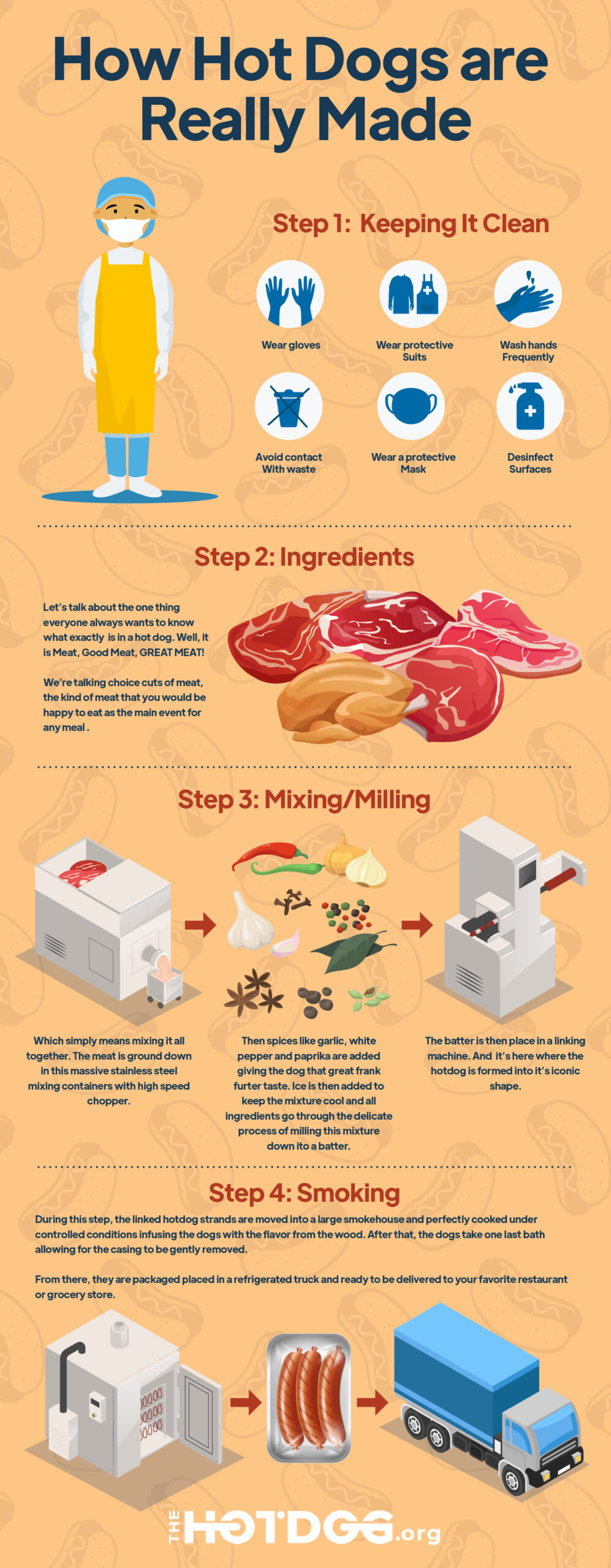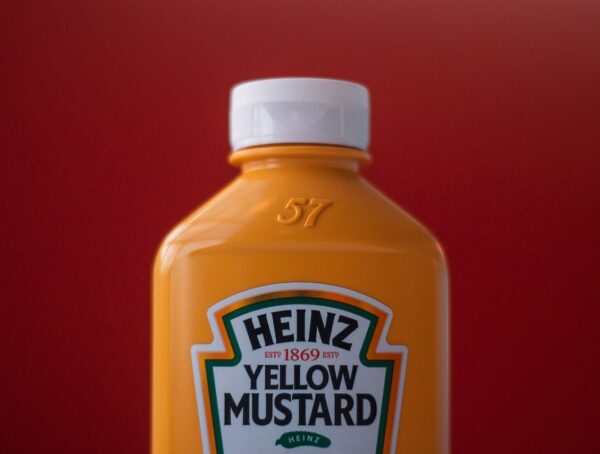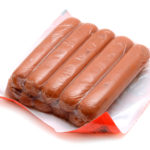A hot dog is a hot, juicy beef sausage in a bun. It’s warm and tasty, evoking fond memories of baseball games and cookouts.
Some people like theirs red and hot, others prefer tan or brown. You’ve probably had one before, but do you know what are hot dogs made of?
There is a lot of ‘fake news’ out there, so let’s set the record straight.
The myth goes that hot dogs used to be called “dachshund sausage” back in the day. They were said to first be sold to a German immigrant named Charles Feltman out of a stand in New York in the 1860s, being originally a German food staple.
In the early 1900’s, it became a common food to see at baseball games, and later became popular nation-wide thanks to Nathan’s Famous, a chain hot dog stand.
They often get a bad reputation because of how easily accessible they are.
Hot dog history
Sausages are one of the oldest forms of food. Franks, or frankfurters, originally come from Germany, from the city of Frankfurt.
But where did the word “hot dog” come from?
The hot dog (with bun) as we know it was introduced during the St. Louis “Louisiana Purchase Exposition” in 1904. Frankfurters were being sold with gloves, and the vendor was running low. The vendor, reportedly, asked his brother-in-law, a baker, for help and improvised rolls as a way to hold the dog.
And thus the hot dog was born!
Where did the name come from?
Hot dogs used to be advertised as “dachshund sausages” and rumor has it, that vendors would yell “Get your dachshund sausages while they’re red hot!”
A cartoonist ran with the image, and pretty soon, everybody was calling them hot dogs.
Sausage brats vs. hot dogs
Hot dogs fall under a category of food a la the sausage family. Both are sausages, go on a bun, and taste delicious with ketchup and mustard.
However! They are not the same.
Sausage brats, or bratwurst, is made specifically with pork, beef, or veal. Hot dogs are a smoother consistency, while brats are a coarser texture and can sometimes feel heavier or heartier as a result.
The biggest difference is that hot dogs are fully cooked, while bratwursts are not.
How clean are they?
The truth is, if you eat regular meat in the U.S., you can trust the hot dog (if you’re vegan or vegetarian all together, there are plenty of vegan and/or hot dog options available to you as well!).
Technical gear is worn in the factories while workers are near any meat or food. Literally, they look like they look like they’re dealing with something out of a movie instead of just regular-shmegular hot dogs.
Hand washing stations are present between different stages and rooms and workers need to wash their hands between each room. Can you imagine the amount of water they must go through a day with all that handwashing (and possibly lotion)?!
A USDA inspector is also on site at every facility to make sure these steps for cleanliness are being followed.
How are hot dogs made?
There are many steps to hot dog production. This is because hot dogs are not only seasoned and shaped, but also fully cooked by the time they hit shelves for consumers to purchase.
Like most foods, hot dogs are made with a number of ingredients and flavors to create their signature taste.
Some of the most common ingredients in these sausages include meat, fat, salt, and spices.

Share this Image On Your Site
Here is the basic process for making hot dogs:
- First, ground meat from a variety of animals such as beef, pork, chicken or turkey must be prepared for cooking.
- Once the meat is combined with spices and other ingredients, it is stuffed into casings. The natural casing can be removed before or after cooking, depending on the manufacturer’s preference.
- At this point, the hot dogs are ready to be packaged and sold as fresh products or frozen for later use.
And, here is the expanded version:
- The first part of the hot dog production process is to make sausage. This is done by grinding and mixing pork, beef, or turkey trimmings (or some combination of these meats) with spices and salt.
- The meat is chopped up until it’s very fine and then mixed together with the other ingredients to create a uniform mixture.
- Once the hot dog ingredients are blended together, they are placed into large hoppers that feed the mixture into tubes. The tubes are attached to funnels at one end and have an opening at the other end for attaching casings.
- As the mixture travels through the tube from the hopper, it is formed into long rolls, and the casing slides over this paste as it is being formed.
- As the sausage rolls exit the tube, they are cut apart to form individual hot dogs.
- Once prepared in this way, there are two ways that hot dogs can be processed further: cooked or uncooked. In some cases, uncooked hot dogs will be smoked before packaging to give them flavor without actually cooking them through.
What are hot dogs made of?
Another part of a USDA inspector’s job when overseeing hot dogs being made is overseeing quality cuts of meat – the hot dog ingredients.
No, your eyes did not deceive you!
Hot dogs, unlike the rumors, have to be made of quality cuts of meat, as part of USDA food standards. That means they are made of the same cuts of meat you find at your regular grocery store (sometimes, bacon, ham, etc.)
Depending on the hot dog, links are made of majority beef, pork, turkey, chicken (depending on the type you’re buying), or a mix.
Only meat products go into an American hot dog – thus the “beef franks” or “beef hot dog” references on the packaging.
How do hot dogs get their shape?
Ok, we know, this next part does not sound as fun. But after choosing the best cuts, hot dogs are chopped and milled very finely with a meat grinder and blended with herbs and spices.
Depending on the kind of hot dog you get, you might get some of the following spices: black pepper, white pepper, garlic, onion, or paprika.
With the variety available on the market these days, I’ve also seen jalapeno, or apple, soy sauce or teriyaki sauce, Italian seasoning, and much more.
Industry secret ingredient
Ice is added to the ground meat to help it retain moisture as it is ground into a meat batter.
If you’ve ever made burgers at home, you might have heard of a similar trick. Adding ice to your burgers when it cooks can help keep the meat moist.
The same thing is done to hot dogs when it’s being made to keep it cool and moist.
Smoking for flavor
After that, they are formed into links for smoking. Often, these are made in high tech smokers that are able to do this efficiently and en masse. Once that’s done, they are steamed to pop them out of their link casing.
You know the wrinkled ends of hot dogs?
Those are the shapes of the casing molded into the hot dog. After steaming, they are ready for eating or sent to a vendor to serve, like at your favorite sports stadium.
Hot dogs hold so much nostalgia for people because of their connection with summers, pool parties, and barbecues–the simple pleasures in life.
The hot dog condiments
Over the years, hot dogs have really gotten a bad rep. But really, they’re no different than other kinds of meat you can find at your grocery store.
Along with a hot dog bun, they can be dressed up, dressed down, and often with very little effort.
A standard condiment may include ketchup or mustard but, depending on the region, some toppings include, but are not limited to:
- Sliced tomato
- Diced onion (you can have it white, green, raw, sauteed…)
- Pickle relish
- Chili (vegetarian or meat-laden)
- Sliced jalapeño
- Sauerkraut
- Creamy horseradish
- Cheese
- Salt
Some even crazier toppings you may, or may not have heard, might include:
- Doritos
- Pulled Pork
- BBQ Sauce
- Bacon
- Black Bean Salsa
- Fried Egg
- Guacamole
- Garlic Aioli
- Blue Cheese
How to spot the good from the bad ingredients
All hot dogs are not created equal: while some are of high quality, others are filled with fillers and binders that can keep them light on your wallet, but heavy on your stomach.
For example, have you noticed that hot dogs often come in 8-packs when other meats like chicken breasts come in quantities of 12?
That’s because hot dog manufacturers try to maximize their profits by bulking up hot dogs with fillers and binders. These additives hold ingredients together, but they also make the hot dog denser—so companies can sell fewer hot dogs per pound.
Fillers and binders can be anything from bread crumbs to soy protein concentrate to mechanically separated meat (which is essentially a paste of crushed bones, skin, and organs).
When looking for high-quality hot dogs, you should avoid these additives.
The good news is that it’s as easy as reading the label!
Take the time to check out the ingredients list before you buy—if you don’t recognize an ingredient or it sounds like a filler or binder, it probably is.
Another way you can spot high-quality hot dogs is by their appearance. Some brands of hot dogs can look lighter or darker than others, and this is an indicator of smoke level, not quality (darker hot dogs are often smokier).
All of the hot dogs in a package should be uniform in color.
Bottom line on what’s in a hot dog
With such large variety and often at a great price point, hot dogs truly are the food of the people.
They often get a bad reputation for how they are made, but that’s largely un-deserved and may have started as true back in the day when we did not refrigerate food or care how our meat was handled.
We have come a long way since then.
Hi there all you hot dog fans and all you hot dog questioners. And welcome to how hot dogs are made.
I know a lot of you out there have been wondering for a long time now how exactly are hot dogs made. No BS. NO fluff. No fake news. Just some good old-fashioned food facts.
In this video, we’re going to take you behind the scenes and into the factory. So, let’s show you how it all goes down, starting with cleanliness.
Step One: Cleanliness
I was actually pretty surprised to see all the work put into keeping everything so pristine and clean.
From the floors to every human walking through the doors, including us, every person has to wash their hands for at least 20 seconds every single time they enter – which feels like a really long time.
Plus, you have to get geared up in approved protective ware. Cleanliness is clearly top of mind. Turns out it has to be.
Government regulations mandate it that’s why factories across the U.S. have on-site USDA inspectors and, yeah, I’m sure you’re thinking, “that’s all great everything’s clean. But let’s talk about the one thing everyone always wants to know. What exactly is in a hot dog?”
Step Two: Ingredients
Well, ready for the big reveal? It’s meat. Good meat. Great meat even. No scraps, no leftovers. We’re talking choice cuts of meat the kind that you would be happy to eat as the main event for any meal. Which kind of shocked me, actually, considering all those mystery meat rumors I’ve heard.
Plus, we learned it’s virtually impossible to make hot dogs with anything but quality cuts of meat because of that government inspector we mentioned before.
I’m sure you’re thinking, seriously? Turns out, yeah, seriously!
Those inspectors are in the factories day in and day out making sure only healthy cuts of beef, pork, turkey, and chicken are the only products going into America’s hotdogs. And, that’s just the beginning of the process.
Step Three: Mixing / Milling
Next up a step called milling – which simply means mixing it all together. The meat is ground down in these massive stainless steel mixing containers with high-speed choppers.
Then spices like garlic, white pepper, and paprika are added giving the dogs that great frankfurter taste. Ice is then added to keep the mixture cool and all of the ingredients go through the delicate process of milling this mixture down into a batter.
The batter is then placed in a linking machine and it’s here where the hot dog is formed into its iconic shape.
Step Four: Smoking
And last, but certainly not least, the final step: smoking. During this step, the linked hotdog strands are moved into a large smokehouse and perfectly cooked under controlled conditions infusing the dogs with the flavor from the wood.
After that, the dogs take one last bath allowing for the casings to be gently removed. From there they are packaged placed in a refrigerated truck and ready to be delivered to your favorite restaurant or grocery store.
As you can see, even the best chefs in the world would have a pretty tough time making a hot dog from scratch. It’s not an easy process and takes a lot of time effort and care. But in my humble opinion, it’s worth every bite.
We hope this sneak peek into the secret world of hot dogs made you feel better about chomping down on a dog. I know it did for me and now I can finally answer the age-old question of how hot dogs are made.
More from Articles
Hot Dogs in Cinema: Iconic Hot Dog Movie Moments
Hot dogs, the classic street food we all adore, have had some pretty memorable moments in the world of cinema! Introduction …
Fun Hot Dog Serving Ideas At Children’s Parties
If you're looking to delight your little guests with something as fun to eat as it is tasty, look no …
The Best Hot Dog Sauces from Around the World
Embark on a global culinary journey as we explore the best hot dog sauces from around the world! Hot dogs vary …
















